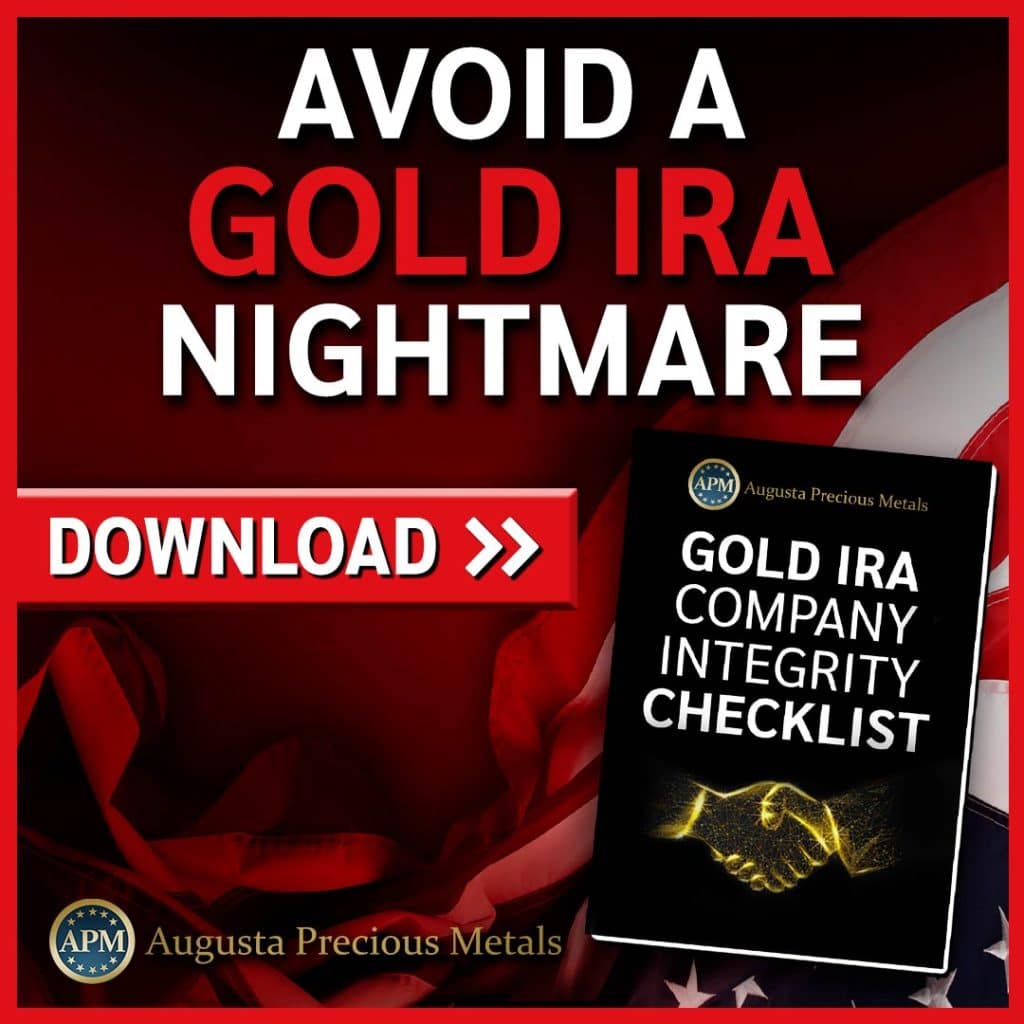Precious Metals IRA Fees

When you invest in a Precious Metals IRA, you're looking at a necessary one-time setup fee as well as annual storage fees. Some of these fees may be waived dependent on the gold IRA company you choose, for which we have provided information. To gain a better understanding of precious metals IRA fees and their variability, we will cover:
- The Costs of Gold IRAs
- Other potential fees
- Factors Influencing Gold IRA Fees
- Ways to Minimize Gold IRA Fees
- Long-term vs. short-term costs
By carefully evaluating these costs and exploring ways to minimize them, you'll ensure a more cost-efficient and potentially profitable Precious Metals IRA investment journey. This exploration will reveal more nuances and strategies to optimize your IRA's performance.
The Costs of Gold IRAs
When considering a gold IRA, you'll encounter several types of fees, including setup, storage, transaction, wiring, and annual maintenance costs. Each of these fees plays a crucial role in the overall expense of maintaining your gold IRA, with variations depending on the custodian and the specifics of your account. It's essential to analyze these costs carefully to ensure your investment aligns with your financial goals and budget.
Setup Fees
You'll typically encounter a one-time setup fee ranging from $50 to $100 or more to initiate your gold IRA, depending on the chosen company's pricing structure. This fee covers the cost of creating your self-directed IRA, a necessary step to start investing in precious metals like gold. It's important to understand that this fee is not uniform across all providers; it varies significantly based on the custodian's policies and the service package you choose. Analyzing this fee is critical as it directly impacts your initial investment cost. While it might seem like a small part of your overall investment, selecting a company with a reasonable setup fee can contribute to minimizing your short-term costs, thus enhancing your investment's overall efficiency from the onset.
Storage Fees
Storing your precious metals in an IRS-approved depository incurs annual storage fees, typically around $125 or more, significantly influencing the overall cost efficiency of your Gold IRA. These fees can escalate depending on the volume of gold you hold and whether you opt for private vault storage. For larger accounts, storage fees might range from 0.5-1% of the precious metal value, underscoring the importance of considering these costs in your investment strategy. It's essential to analyze how storage fees impact your Gold IRA's long-term growth potential. Given that these fees are recurring, they can diminish your returns over time, especially in a fluctuating market. Thus, understanding and calculating these costs is crucial for maintaining an efficient and profitable Gold IRA.
Transaction Fees
Navigating the landscape of Gold IRAs, it's crucial to understand that each time you buy, exchange, or sell precious metals, you're incurring transaction fees typically ranging from $10 to $100. These fees are a fundamental aspect of managing your precious metals IRA and can significantly impact your investment's cost efficiency over time. The exact amount charged per transaction depends on various factors, including the custodian's fee structure and the size of the transaction. It's essential to scrutinize these fees carefully, as they can vary widely among custodians. In your quest to maximize your investment's value, paying attention to transaction fees is as critical as considering the potential appreciation of your precious metals. Therefore, a detailed comparison of custodian fee schedules is recommended to ensure you're not eroding your returns with excessive transaction costs.
Wiring Fees
Understanding transaction fees is vital, and another aspect to consider when managing your Gold IRA involves wiring fees, which incur a flat charge for each outgoing fund transfer. These fees can quickly add up, especially if you're making multiple transactions within a short period. Here's what you need to know:
- Every outgoing wire typically costs around $25.
- These fees are flat, meaning they don't vary with the amount being transferred.
- Frequent transactions can significantly increase your overall costs.
- Wiring fees are standard across many custodians, but it's worth comparing.
- Planning your transactions can help minimize these fees, consolidating transfers where possible.
Being mindful of wiring fees and strategizing your transactions can help in managing the costs associated with your Gold IRA more effectively.
Annual Maintenance Fees
While the allure of a Gold IRA is undeniable, it's crucial to consider that annual maintenance fees can significantly impact your investment's net growth. These fees, necessary for keeping records per IRS requirements, range widely from $200 to thousands of dollars annually. The variation hinges on your account's total value and the custodian managing your assets. This means, as your investment grows or if you choose a custodian with higher fees, the cost of maintaining your Gold IRA could escalate, eating into your profits. It's essential to analyze these fees closely before committing. By understanding the fee structure, you're better positioned to make decisions that preserve your investment's growth potential, ensuring that the charm of a Gold IRA doesn't lose its shine over costly maintenance charges.
Other potential fees
Beyond the standard setup, maintenance, and transaction fees, you'll also encounter other charges that can impact the overall cost of your Precious Metals IRA. These include insurance fees, which protect your investment against loss or theft, and metal shipping and handling fees, covering the costs of safely transporting your precious metals to storage. Additionally, audit fees, liquidation fees, and wire transfer fees are critical to understanding, as they can significantly affect your IRA's long-term profitability.
Insurance fees
Regarding insurance fees for your precious metals IRA, it's crucial to determine if these costs are separately billed or included within the storage fees to ensure full transparency.
- Separate Billing vs. Inclusion: Understand whether insurance fees are billed separately or included in your storage fees.
- Cost Variability: Insurance costs can vary depending on the custodian and the value of the metals stored.
- Risk Coverage: Assess what risks the insurance covers, such as theft, damage, or loss.
- Provider Policies: Each custodian may have different policies regarding how insurance fees are handled.
- Transparency and Understanding: Ensure that the fee structure, including insurance costs, is clearly outlined and understood before committing to a specific provider.
Analyzing these factors helps in understanding the full scope of potential costs associated with insuring your precious metals IRA.
Metal shipping and handling fees
In addition to the primary fees associated with a Precious Metals IRA, you'll also encounter charges for the shipping and handling of your precious metals, which cover the secure transport and any insurance required during transit. It's crucial to understand these fees as they can vary significantly depending on the type of metals you're investing in, their weight, and the distances involved. Providers often calculate these fees based on the current rates for secure shipping services and insurance costs, which can fluctuate based on market conditions. While these expenses might seem minor compared to the overall investment, they're essential for ensuring the safe delivery and protection of your assets. Always review these charges carefully, as they impact the total cost of maintaining your Precious Metals IRA.
Audit fees
How do audit fees impact the overall costs of managing your Precious Metals IRA, considering they're charged for verifying the existence and condition of stored assets? While these fees might seem like a minor detail, they play a crucial role in ensuring the integrity and security of your investment. Here's what you need to know:
- Audit fees ensure transparency and trust between you and the custodian.
- They're essential for verifying asset authenticity and condition.
- These fees can vary based on the custodian and the frequency of audits.
- Regular audits help in maintaining compliance with regulatory standards.
- Though an additional cost, they contribute to the long-term security of your investment.
Understanding these charges helps you gauge the full cost of owning a Precious Metals IRA, beyond the initial setup and annual maintenance fees.
Liquidation fees
While audit fees play a significant role in ensuring the security of your Precious Metals IRA, it's also important to understand the impact of liquidation fees should you decide to sell your gold holdings. Unlike the more straightforward transaction fees for buying or selling, liquidation fees can encompass a range of additional costs that are vital to consider. These fees may include appraisal charges, required to assess the current market value of your metals, and market analysis fees, which provide insight into the best timing and approach for liquidation. Moreover, specific liquidation charges, distinct from regular transaction fees, could apply, impacting the overall cost of converting your precious metals back into cash. It's critical to factor in these potential expenses to accurately evaluate the financial implications of liquidating your assets within a Precious Metals IRA.
Wire transfer fees
For investors managing a gold IRA, wire transfer fees are an additional cost to consider, as these charges vary between custodians and can significantly impact the overall expense of the account. Understanding the nuances of these fees is crucial:
- Variability: Wire transfer fees differ greatly among custodians, necessitating thorough comparison.
- Quick Access: They're often incurred for fast funding or withdrawal needs.
- Cost Impact: Even small differences in fees can add up, affecting your investment's net return.
- Negotiation Potential: Some custodians may offer lower fees upon negotiation, especially for larger transactions.
- Transparency: Always seek clear information on these fees to avoid unexpected charges.
Analyzing these aspects ensures you're not caught off guard by wire transfer fees, allowing for more strategic financial planning in your gold IRA management.
Late payment or underfunding fees
Investors should be aware that failing to maintain the minimum balance or timely payments may result in the imposition of penalties or late fees by the company. These costs can significantly impact your overall investment returns, making it imperative to understand the specifics of these charges. Late payment or underfunding fees are not standardized across custodians, meaning each company may set its own rates and rules regarding when these fees are applied. Typically, these fees are charged when an account falls below the required minimum balance or when scheduled payments are missed. It's crucial to review your custodian's fee schedule and stay vigilant about your account's status to avoid these additional charges, as they can accumulate over time, eroding the value of your investment.
In-kind transfer fees
When you transfer gold or other precious metals into an IRA as an in-kind contribution, you may face evaluation or processing fees. These fees are essential to understand as they can impact the overall cost of maintaining your precious metals IRA. Here's what you need to know:
- Evaluation Fees: May apply for assessing the value of the precious metal being transferred.
- Processing Fees: Charged for the paperwork and administrative work involved in the transfer.
- Depository Fees: Some custodians may charge a fee for transferring the metal into their depository.
- Handling Fees: Additional costs for handling and managing the physical transfer process.
- Tax Implications: Be aware of any tax considerations that may arise from the transfer, which aren't direct fees but can affect your overall financial strategy.
Minimum balance fees
Maintaining a minimum balance in your precious metals IRA is crucial, as falling below a specified threshold can trigger additional fees. These minimum balance fees are structured by custodians to ensure that your account maintains a sufficient level of funding to justify the administrative and operational costs associated with managing your investments. The specific amount varies by provider, but falling short of this balance often results in a fee that could erode your investment's value over time. It's essential to understand your custodian's policy on minimum balances to avoid unexpected charges. By keeping a close eye on your account balance and making necessary adjustments, you can prevent these fees and preserve the integrity of your investment strategy.
Paper statement fees
While managing your precious metals IRA, it's also important to be aware that opting for paper statements over electronic ones can incur additional fees from custodians. Here's what you need to know:
- Environmental Impact: Opting for paper statements has a larger environmental footprint compared to electronic statements.
- Cost Variability: Fees for paper statements can vary widely among custodians, adding an unforeseen cost to your account.
- Frequency Matters: The more statements you receive, the higher the fees could potentially climb.
- Avoidable Cost: These fees are entirely avoidable by opting into electronic statements.
- Check Your Agreement: It's essential to review your custodial agreement or ask directly to understand the specific fees associated with paper statements.
Being informed can help you avoid unnecessary costs and manage your precious metals IRA more effectively.
Account closing fees
Understanding account closing fees is essential as they can significantly impact the overall cost of managing your precious metals IRA. When you decide to close your account, you're not just ending a service; you're initiating a process that can entail various charges. Typically, custodians charge a flat termination fee, which can be around $225 for full termination and $50 for partial termination. However, this isn't the end of potential costs. You might also face market adjustment fees, which account for the fluctuation in metal prices between initiation and closure, and final audit fees, ensuring all transactions and holdings are accurately accounted for. These additional costs can vary based on the custodian's policies and the current market conditions, making it crucial to review your IRA agreement and consult your custodian for a comprehensive breakdown of potential closing expenses.
Finding the right gold IRA company for your needs
Hedging your portfolio with hard assets such as gold and silver is necessary to mitigate risk. Finding the right gold IRA company to work with for your specific needs is just as crucial.
Depending on whether you are a high-net investor looking for the most competitive prices or require a lower investment minimum and affordable entry to the gold market, we have researched and reviewed our best 4 gold IRA and precious metal investment companies that meet those individual needs. Whether you prefer a gold IRA or owning the physical gold in your place of residence.
Tap the banner below to visit Augusta Precious Metals to receive their gold IRA checklist
Factors Influencing Gold IRA Fees
When you're considering a Gold IRA, the fees you'll face can significantly vary based on several factors. Your choice of custodian, the types of precious metals you opt for, and the specific services included in your package play crucial roles in determining the overall cost. It's essential to analyze these elements closely to manage and potentially minimize the fees associated with your Gold IRA.
Choice of Custodian
How does the choice of a custodian impact the fees you'll incur with a Gold IRA? The selection of a custodian is pivotal, as different providers have varied fee structures. Here's what to consider:
- Setup Fees: Some custodians charge higher initial fees for setting up your Gold IRA.
- Annual Maintenance Fees: Annual fees can vary significantly between custodians, affecting long-term costs.
- Storage Fees: Custodians might offer different storage options, influencing the fee based on security and accessibility.
- Transaction Fees: The cost per transaction, including buying and selling metals, can differ.
- Additional Fees: Be aware of potential hidden fees, such as for insurance or wire transfers, which can add to the overall cost.
Choosing the right IRA custodian requires a careful comparison of these fees to ensure cost-effectiveness.
Types of Precious Metals
Selecting the right custodian impacts your Gold IRA fees significantly, but it's also vital to consider the type of precious metals you choose, as this decision influences storage and overall costs. While gold is a popular choice, incorporating silver into your IRA can increase storage fees due to its bulkier volume for the same dollar value. This factor makes it crucial to analyze not only the market value but also the physical characteristics of each metal. Understanding the specific costs associated with storing gold versus silver, or other precious metals like platinum and palladium, helps in making an informed decision that aligns with your investment goals and budget. It's this blend of market value and physical attributes that dictates the cost-effectiveness of your precious metals IRA.
Services Included
Understanding the services included in your gold IRA maintenance package is crucial, as optional features can significantly impact your annual fees. When you're choosing a provider, it's essential to analyze the components of their service package. This includes:
- Account setup and management: The initial creation and ongoing management of your IRA.
- Storage solutions: Options for secure storage of your precious metals, which can vary in cost.
- Transaction handling: Buying, selling, and trading within your IRA.
- Reporting and compliance: Necessary regulatory reporting and compliance management.
- Customer support: Access to knowledgeable support for your account questions and transactions.
Each of these services contributes to the overall cost of maintaining a gold IRA. Therefore, it's important to consider not just the base fees, but how these additional services may affect your total annual expenses.
Best Gold IRA for Low Minimum Investment
Ways to Minimize Gold IRA Fees
To minimize Gold IRA fees, you must carefully select a reputable custodian that aligns with your financial goals and investment strategy. Negotiating fees with your chosen custodian can significantly reduce initial and ongoing costs. Opting for low-cost storage options also plays a crucial role in keeping expenses down, ensuring a more cost-effective Gold IRA management.
Choose a Reputable Custodian
When shopping for a gold IRA custodian, it's crucial to prioritize finding a reputable, accredited provider with a proven track record in managing these specific types of retirement accounts. This choice not only ensures the safety and security of your investments but can also significantly impact the fees associated with your account. To help you make an informed decision, consider these key points:
- Look for custodians with industry accreditations and positive customer reviews.
- Examine their experience in handling gold IRAs specifically.
- Assess the efficiency of their account setup and management processes.
- Check for transparency in their fee structure to avoid hidden costs.
- Compare their customer service quality, focusing on responsiveness and professionalism.
Choosing the right custodian is a critical step in minimizing gold IRA fees and securing your retirement savings.
Fee Negotiation With Custodians
Negotiating fees with your gold IRA custodian can significantly reduce the overall costs of maintaining your precious metals retirement account. It's crucial to understand the types of fees involved and how they impact your investment. By engaging in discussions with your custodian, you may uncover opportunities to adjust fee structures in your favor. Evaluate whether scaled or flat fees suit your account size better, especially as it grows. Don't overlook the potential for fee waivers or discounts, particularly in the first year. However, be wary of offers that seem too good to be true, as fees that escalate sharply in subsequent years can negate initial savings. Always calculate long-term costs to ensure you're making a financially sound decision.
Choosing Low-Cost Storage Options
After exploring the importance of fee negotiation with custodians, it's equally vital to examine how selecting low-cost storage options can further reduce the expenses associated with a Gold IRA.
- Compare Depository Fees: Different depositories work with your custodian and offer varying fee structures. It's crucial to compare these to find the most cost-effective option.
- Opt for Commingled Storage: Commingled storage often comes at a lower cost than segregated storage, without significantly increasing risk.
- Understand Storage Fee Schedules: Knowing how fees are calculated, whether fixed or percentage-based, can influence your storage choice.
- Negotiate Storage Fees: Don't hesitate to negotiate storage fees, as some custodians may offer discounts for long-term storage agreements.
- Review Storage Options Annually: Periodically reassess your storage arrangement to ensure it remains the most cost-effective option.
Long-term vs. Short-term costs
How do the immediate costs of setting up and maintaining a gold IRA compare to the long-term fees that can significantly impact your investment's growth over time? Initially, you're faced with setup fees, the first year's maintenance fee, the initial purchase of gold, and the costs to ship and store your gold in an approved depository. These upfront expenses might seem manageable, especially when you're focused on the potential growth and security a gold IRA offers. However, it's the long-term costs, such as ongoing maintenance and storage fees, as well as the costs associated with buying, selling, or exchanging gold, that you need to scrutinize closely.
Over the years, these recurring fees can eat into your investment's returns. Particularly, scaled fees, which increase as your account grows, can take a significant chunk out of your retirement savings. It's not just about the dollar amount you pay today but how those fees compound and affect your investment's net growth over time. Providers may charge a range of fees, including transaction fees for trades within your IRA, and potentially high liquidation fees if you decide to close your account or withdraw funds.
To safeguard your investment's growth, it's crucial to understand not only the immediate costs but also how long-term fees work. Choosing a provider with lower fees and understanding the fee structure can make a substantial difference in your IRA's performance. Always consider both the short-term and long-term costs in your decision-making process, ensuring that what seems like a small fee now doesn't become a financial burden as your account value increases.
Conclusion
In conclusion, navigating the costs associated with a precious metals IRA requires diligent research and careful consideration. You'll find that setup, annual administrative, storage, transactional, and potential additional fees vary widely among providers. By understanding these costs and the factors influencing them, you can adopt strategies to minimize expenses, balancing long-term and short-term financial impacts. Ultimately, your ability to scrutinize and compare fee schedules will be pivotal in managing a cost-effective precious metals IRA that aligns with your investment objectives.
Take Advantage of the Best Prices. Attend a Gold Investment Webinar for Investors with 100k or More to Protect Hosted by Augusta Precious Metals
Gold IRA FAQs

Adam ONeill
Author, lifelong investor, and creator of PreciousMetalsInvestmentPortfolio.com




